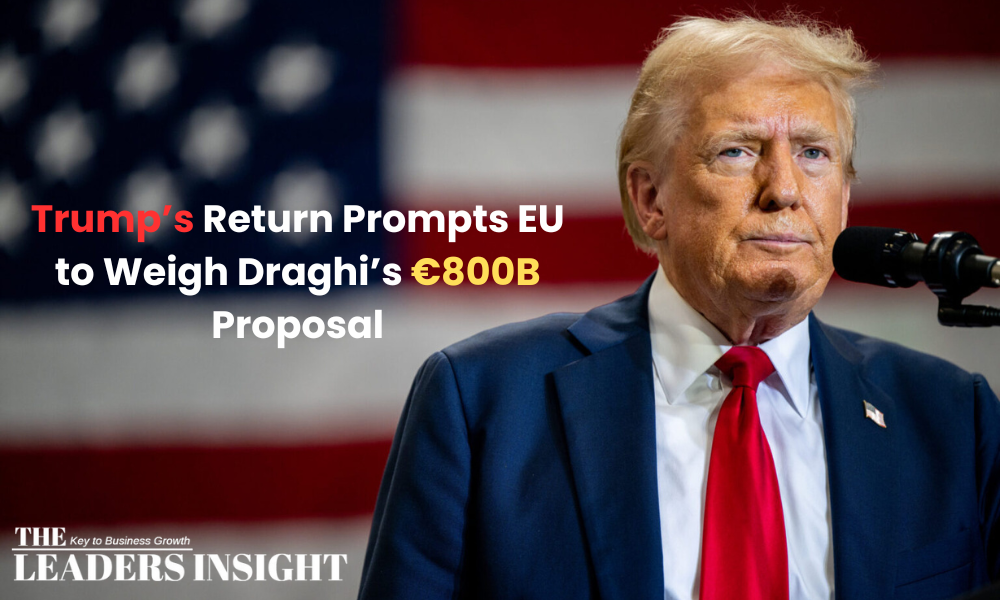Trump’s Return Prompts EU to Weigh Draghi’s €800B Proposal

Donald Trump’s reemergence on the political stage has sparked fresh conversations across Europe, prompting a wave of strategic discussions among EU leaders. As Trump’s potential policies could impact global trade and security, Europe is considering a new fiscal direction championed by Mario Draghi. The former Italian Prime Minister and ECB president has put forth a bold €800 billion economic initiative to bolster the EU’s resilience and economic independence in an increasingly competitive global market.
Europe’s Response to Global Shifts
Trump’s return could signal a shift in U.S.-EU relations. Historically, his presidency disrupted traditional alliances, and his influence on international policy is likely to echo if he regains office. This has led EU leaders to contemplate Draghi’s €800 billion proposal, which centers on enhancing European infrastructure, green energy projects, and digital innovation to reduce dependency on foreign powers.
Draghi argues that Europe needs to “take control of its economic future” by investing heavily in foundational sectors. His plan, however, has encountered both support and skepticism among member states. While some leaders see it as an opportunity to fortify Europe’s position in the global economy, others are wary of the fiscal implications.
The €800 Billion Challenge
Draghi’s plan calls for a significant investment into various sectors to modernize Europe’s economic landscape. His vision is focused on enhancing digital infrastructure, fostering renewable energy projects, and boosting manufacturing capabilities. The aim is to transform Europe into a self-sustaining economy that’s resilient to external shocks, especially as geopolitical shifts, like Trump’s return, could lead to new trade policies that affect European markets.
To accomplish this, Draghi suggests that EU member states contribute to a collective fund dedicated to high-impact projects. European Commission officials have already begun to assess the viability of this ambitious plan, which they believe could enable Europe to close the economic gap with the U.S. and China.
Political Divide in the EU
Although Draghi’s proposal has garnered attention, it has also sparked division among EU member states. Countries with stronger economies, such as Germany and France, are more open to the plan, seeing it as a way to secure Europe’s future. Meanwhile, fiscally conservative nations, like the Netherlands and Sweden, express concerns about the financial burden and long-term risks.
Opposition to Draghi’s initiative often centers on fears of accumulating public debt. Leaders in these countries argue that while investments are crucial, they should not come at the cost of future financial stability. This has led to ongoing negotiations, with the European Commission exploring ways to create a balance between robust economic stimulus and fiscal responsibility.
Economic Experts Weigh In
Economists have mixed opinions about the potential impact of Draghi’s plan. Supporters believe that investing €800 billion will revitalize Europe’s economy and ensure its competitiveness in the face of external pressures, such as the U.S.-China rivalry and Trump’s potential policy shifts. They argue that digital transformation and green investments could stimulate job creation and boost GDP across the EU.
However, some experts question the feasibility of such a massive investment without compromising financial stability. They argue that the EU must develop a clear and transparent plan to manage the allocation of funds effectively. EU watchdogs are also advocating for stronger oversight mechanisms to prevent mismanagement of funds and ensure that each project delivers measurable benefits to the European economy.
Geopolitical Implications
With Trump’s possible return, European leaders face a crossroads. The EU-U.S. relationship may undergo another shift, impacting trade agreements and military alliances. Trump’s America-first approach could prioritize bilateral agreements, potentially sidelining the EU in favor of more direct negotiations with individual nations. This has reignited discussions about Europe’s need for economic autonomy, a core element of Draghi’s strategy.
The proposed investments in renewable energy and digital transformation are particularly crucial as they align with global trends toward sustainability and technological advancement. According to analysts, these areas are essential for Europe to maintain relevance on the global stage, especially in a world increasingly influenced by AI and climate initiatives.
Steps Moving Forward
To implement Draghi’s plan, European leaders will need to address funding sources and governance structures. The European Investment Bank has shown interest in playing a central role, offering a possible route to finance these projects. The European Parliament has also started discussing legislation to facilitate streamlined investment, although the process is expected to take time.
The European Central Bank (ECB) may need to adjust its monetary policies to support Draghi’s vision, which could include low-interest loans or incentives for sustainable projects. ECB officials have not yet committed, but discussions are underway regarding how best to align monetary policy with this ambitious fiscal strategy.
A Unified Vision or Fragmented Approach?
As discussions continue, Draghi’s €800 billion plan serves as a litmus test for European unity. If the EU can come together on this initiative, it could mark a turning point for Europe’s economic and political independence. However, failure to reach a consensus could leave Europe vulnerable to external economic and geopolitical pressures, especially if Trump reestablishes his influence on global policy.
Whether or not EU leaders rally behind Draghi’s proposal, it is clear that Europe is at a pivotal moment. In an era marked by rapid political shifts and economic uncertainty, the continent must either act decisively or risk being left behind on the global stage.
